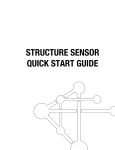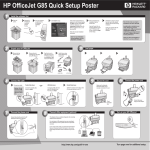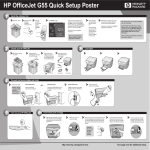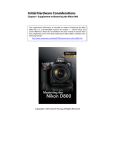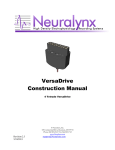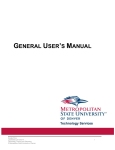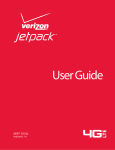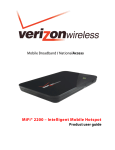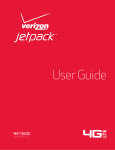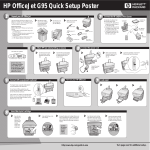Download STRUCTURE SENSOR & DEMO APPS TUTORIAL
Transcript
STRUCTURE SENSOR & DEMO APPS TUTORIAL 1 STRUCTURE SENSOR & DEMO APPS TUTORIAL WELCOME TO YOUR NEW STRUCTURE SENSOR Congrats on your new Structure Sensor! We’re sure you’re eager to start exploring your Structure Sensor’s capabilities. And to help you get the most out of your experience, we’ve put together this quick start guide to help familiarize you with this advanced accessory. WHAT’S INCLUDED IN THE BOX Your Structure Sensor should arrive with the following: • One Structure Sensor • One data cable with Apple Lightning connector • One AC battery charger • One screwdriver • Four M1.6 screws • One user manual Your iPad attachment bracket will arrive in a separate box/package. CHARGING YOUR STRUCTURE SENSOR Charging your Structure Sensor’s internal battery is simple. Simply connect the supplied AC charger to the round port on the side of the Structure Sensor, and then plug the other end into any standard 2-pronged wall outlet as found in the United States (if you’re outside of the US or Canada, you will need to use an appropriate adaptor). © 2014 Occipital, Inc. http://structure.io 2 STRUCTURE SENSOR & DEMO APPS TUTORIAL An LED indicator on the Structure Sensor’s glass face will pulse when your Structure Sensor’s battery is charging. As soon as your battery is completely charged, the LED indicator will stop pulsing and instead will stay on until you disconnect the AC charger. CONNECTING YOUR STRUCTURE SENSOR TO YOUR IPAD Step 1 – Attaching your Structure Sensor to the bracket From top to bottom: iPad (4th Generation) precision bracket with aluminum latch; iPad Air 3D printed temporary bracket; iPad mini with Retina display 3D printed temporary bracket Your Structure Sensor has arrived with one of three available brackets to connect it to different Apple iPad models (the currently available brackets are for the iPad [4th Generation], iPad Air and iPad mini with Retina display). © 2014 Occipital, Inc. http://structure.io 3 STRUCTURE SENSOR & DEMO APPS TUTORIAL Using the supplied screwdriver and 4 screws, attach the Structure Sensor to the supplied bracket. Place the Structure Sensor in front of the bracket, and then use the supplied screwdriver and 4 screws to attach the two together. The data and charging ports on the Structure Sensor should be facing to the left as you look at the Structure Sensor and bracket. The proper orientation for the Structure Sensor is to have the two data ports facing to the long side of the bracket. © 2014 Occipital, Inc. http://structure.io 4 STRUCTURE SENSOR & DEMO APPS TUTORIAL Step 2 – Attaching the Structure Sensor and bracket to your iPad If you have received a temporary 3D printed bracket, simply slide the bracket plus Structure Sensor onto the top of your iPad. Make sure that the hole in the bracket is centered around the iPad camera. Left: Sliding the bracket onto an iPad Air. Right: The bracket firmly seated. Left: The bracket firmly seated on the iPad Air. Right: The bracket’s iPad camera opening. © 2014 Occipital, Inc. http://structure.io 5 STRUCTURE SENSOR & DEMO APPS TUTORIAL If you have received the final precision bracket with aluminum latch, start by sliding the bracket plus Structure Sensor onto the top of your iPad, making sure that the aluminum latch is in its open position. Left: Sliding the bracket on an iPad (4th Gen). Right: The bracket firmly seated. Left: Sliding the bracket on an iPad (4th Gen). Right: The bracket firmly seated. The bracket’s iPad camera opening centered around the iPad camera. © 2014 Occipital, Inc. http://structure.io 6 STRUCTURE SENSOR & DEMO APPS TUTORIAL As soon as the bracket is firmly seated on top of your iPad, and you have ensured that the hole in the bracket is centered around the iPad camera, close the latch by pressing down on it with your thumb. Step 3 – Attaching the Lightning cable to your Structure Sensor and iPad Connect the supplied Lightning cable by connecting it to your Structure Sensor first. The wide end of the cable connects to your Structure Sensor, and the goldcolored pins should be facing up as you press it firmly into the Structure Sensor. © 2014 Occipital, Inc. http://structure.io 7 STRUCTURE SENSOR & DEMO APPS TUTORIAL Next, connect the other end of the cable with the Apple Lightning connector into your iPad. Your Structure Sensor is now fully charged and connected to your iPad! © 2014 Occipital, Inc. http://structure.io 8 STRUCTURE SENSOR & DEMO APPS TUTORIAL USING YOUR STRUCTURE SENSOR FOR THE FIRST TIME Using The “Viewer” Demo App The first demo app to try when you first attach your Structure Sensor to your iPad is the “Viewer” demo app. Viewer provides a simple view of what the Structure Sensor sees alongside what your iPad’s color camera sees. Here is what Viewer’s output looks like: The Structure Sensor’s output is on the left. The iPad’s color camera output is on the right. Using The “Object Scanner” Demo App The Structure Sensor also arrives with a simple 3D scanning app called “Object Scanner.” It’s easy to start getting great looking scans quickly and consistently if you learn just a few simple things about using this app. Finding Suitable Objects A great first test for the Object Scanner demo app is to try scanning another person from the shoulders up to the top of the head. The Object Scanner demo app works best for scanning objects the size of a medium-sized stuffed animal up to a human bust. Smaller items will lack detail and may challenge object tracking. Larger objects may be difficult to capture in their entirety. The Object Scanner demo app may have difficulty capturing black surfaces and shiny surfaces. In addition, the Object Scanner demo app will have difficulty capturing intricate features, such as hairs, wires or other fine objects. © 2014 Occipital, Inc. http://structure.io 9 STRUCTURE SENSOR & DEMO APPS TUTORIAL Setting Up Objects To Scan For the best quality scan, please follow these general guidelines: • Stand about 1 meter (or 3 feet) away from the object or the person • Make sure that you have an unimpeded 360-degree path around the object or person so that you may capture an entire scan easily • For objects, placing them at a standard tabletop height allows for the best combination of scanning quality and ease • For objects, placing them on a smooth, flat surface ensures that the Object Scanner demo app will consistently capture great scans • The Structure Sensor works best indoors or outside of direct sunlight Positioning the Scan Area Cube When you first open the Object Scanner demo app and connect your Structure Sensor to your iPad, you will see a large transparent cube appear on your screen. The bottom of this cube has an orange square. The orange square will automatically snap itself to flat surfaces such as floors or walls so that your scan is positioned on a flat plane. Alternatively, if you point the Structure Sensor towards a person, the transparent cube will position itself around their upper torso and head for a bust scan. The transparent cube and orange square determine what objects or people the Object Scanner demo app will capture. © 2014 Occipital, Inc. http://structure.io 10 STRUCTURE SENSOR & DEMO APPS TUTORIAL To scan an object, start by standing about a meter (about 3’) away from the object. Then, center the object within the transparent cube. Once the object is within the cube, you will see that the orange square will now adjust itself to fit over the object you plan to scan. When placed on an object or person, the transparent cube and orange square show what will be captured once the blue “Scan” button is pressed. If parts of the object you plan to scan are not covered in orange, you are standing too close. Back up until those parts are covered. In this picture, the Structure Sensor is too close to the subject to be scanned, as it does not fit entirely in the transparent cube. © 2014 Occipital, Inc. http://structure.io 11 STRUCTURE SENSOR & DEMO APPS TUTORIAL Using the “Pinch” Gesture Because the cube determines what will be captured by the Object Scanner demo, it is important to make sure the cube is the right size for the object to be scanned. The size of the transparent cube can be easily adjusted using the typical iPad “pinch” gesture. Push your thumbs together on your iPad screen to make the cube smaller, and pull them apart to make it bigger. If the cube is too small to contain the object you plan to scan, you can expand the cube by pulling your thumbs apart on your iPad screen. You may also try to move backwards so that you are further from the object you plan to scan. Although the Structure Sensor is a reasonable distance away from the object to be scanned, the scan area cube is too small. Put both thumbs on the touch screen and move them apart to make the scan area cube larger. © 2014 Occipital, Inc. http://structure.io 12 STRUCTURE SENSOR & DEMO APPS TUTORIAL If the cube is too large for the object you plan to scan, then your scan will be of poor quality and you may potentially capture objects in your scan that you do not want. You can shrink the cube by pushing your thumbs together on your iPad screen. You may also try to move closer so that you are nearer to the object you plan to scan. Although the Structure Sensor is a reasonable distance away from the object to be scanned, the scan area cube is too large. Put both thumbs on the touch screen and move them together to make the scan area cube smaller. For the highest quality scans, pinch to shrink the cube so it is just a bit bigger than the object within it that you plan to scan. The size of the scan area cube is just about right to begin scanning this teddy bear. © 2014 Occipital, Inc. http://structure.io 13 STRUCTURE SENSOR & DEMO APPS TUTORIAL Scanning the Object To begin your scan, press the blue “Scan” button. Once you have started, move around the object to capture it. If you notice that there is a hole in the model, you can go back during the same scan to see if the Object Scanner demo app can fill it in. If you have made a mistake during your scan, you can press the red reset button with the circular arrow on it to restart your scan. Click the “Done” button when your scan is complete. As soon as you start scanning, you will see your 3D model appearing on top of your subject in real time. As you continue your scan, you can go back and fill in holes and other problem areas to improve your 3D model. © 2014 Occipital, Inc. http://structure.io 14 STRUCTURE SENSOR & DEMO APPS TUTORIAL Maintaining Tracking On your first few scans, you may notice that the Object Scanner demo app loses track of the object. A warning note will appear on your screen: On rare occasions, the Object Scanner demo app will lose tracking of the object or person you are scanning. You will see this error message if that happens. Try to rematch the scan to the object you are scanning to restart object tracking. If that doesn’t work, try your scan again. If you consistently get object tracking errors during a scan of the same object, that object may not be suitable for scanning. © 2014 Occipital, Inc. http://structure.io 15 STRUCTURE SENSOR & DEMO APPS TUTORIAL Viewing Your Completed Scan To view your scan, click the “done” button. A review screen will appear. You can use your finger to drag the model around to see all sides of it. Once you click the “Done” button, you will automatically be taken to this screen. Use your finger to drag the model around to see it from all angles. You can also click “X-Ray View” to see the underlying mesh of the model that you have captured. When you click the “XRay View” button, the underlying mesh will appear. Click the “Email” link in the upper right hand corner to export an .OBJ file. To share or export a scan, click the “email” link in the upper right hand corner. Click this to email an .OBJ file of your scan to yourself or a friend. Click the “Back” link to reset the app so you can start your next scan. © 2014 Occipital, Inc. http://structure.io 16 STRUCTURE SENSOR & DEMO APPS TUTORIAL MORE APPS ARE COMING SOON! At Occipital, we’re planning on releasing more demo apps and complete apps to expand the functionality of your Structure Sensor. In addition, developers worldwide are now using the Structure SDK to create more great apps, too. We’ll be sure to keep you posted whenever new apps are available for your Structure Sensor. And, if you’re a developer, we’re always here to help you build your own great app for the Structure Sensor! NEED MORE HELP USING YOUR STRUCTURE SENSOR? We’re always ready to help answer any questions or comments you might have about your Structure Sensor. Contact us at [email protected] anytime! If you’re a developer, you should have received an email invitation to our developer forums. If you have not received this invite, contact us at [email protected]. FOLLOW OCCIPITAL AND THE STRUCTURE SENSOR On Twitter http://twitter.com/structure http://twitter.com/occipital On Facebook http://facebook.com/structure3d http://facebook.com/occipital On YouTube http://youtube.com/occipitalhq On the Internet http://structure.io and http://structure.io/developers http://occipital.com Tutorial Version 1.1 (March 5, 2014) © 2014 Occipital, Inc. http://structure.io

















